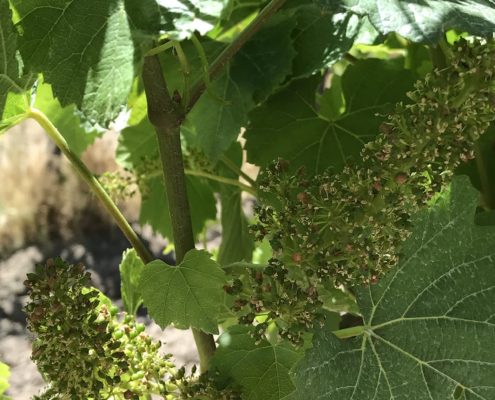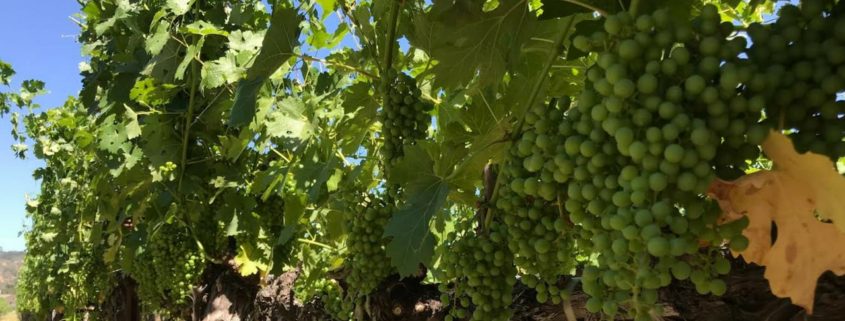Wine Production Part 1 – Growing and Husbandry for the Grapevine
Great vines are made in the vineyard, with little intervention in winemaking. As the old saying goes – “You can make bad wine out of good grapes, but you can’t make good wine out of bad grapes.”
Annual Vineyard Cycle
Budbreak – Day 1: Winter pruning has already commenced (see below). Budbreak occurs at 50 degrees (10 Celsius). Buds look like popcorn before they burst open. The vine rapidly pushes out its first leaves and clusters.

Day 20 showing newly formed grape clusters or Floral Primordium
Bloom – Day 60: The vine flowers. It is crucial that the weather is good during these 2 weeks. Adverse weather can result in Coulure or “shatter” meaning some of the grapes fail to develop. Another problem is millerandage where there are grapes of different sizes and levels of maturity within the same bunch. Successful pollination leads to berry set. During this time we also disc and till under the cover crop.

Flowering
Veraison – Day 100: Until now, the grapes have been small, hard and the color of green apples. Two things happen during veraison: On the outside, the grapes soften and become purple (or yellowish-green on white varietals). More importantly, sugars and phenols (flavors) start to build inside the grape, while malic acid is lost. This continues to accumulate inside the grape until…
Harvest – Day 160: After sufficient maturation, the grapes are ready to be picked. The color should all be uniform and should taste sweet. The seeds turn brown and you can crunch right through them in your mouth. Grapes for sparkling wine are typically picked first, followed by whites, reds then late harvest/dessert wines.
Leaf fall at 1st frost
*I realize that these numbers might not fit every region, but it takes 140 to 160 days from bud break to harvest. This could range from 125 to 200 days in extremes:
Vine Training
One of the common questions we get on a wine tour is “why are vines pruned differently?” It is obvious looking out a window at vines on the side of the road that they come in all different shapes and sizes.
Vine training is the manipulation of vine growth to best suit the environment. The vine must be monitored to ensure balanced growth for this year and next. Over the centuries, several adaptations have occurred which fall into three categories:

Vine Training (left; Bush Vines, center; Vertical Shoot Positioning, right; Big Vine – specifically Open Lyre)
Bush vines (left picture) are how all vines used to be grown. This includes Head Training (all branches comes out at one point like you prune a rose bush), and Vertical Cordon Training (tied to a pole and the branches come out at different heights, reminds me of the way you grow a tomato plant). They tend to lead to uneven ripening as the west side gets hit with the sun during the hotter part of the day. Bush Vines are found in Beaujolais, Australia, California and arid areas around the Mediterranean.
Bush vines are perfect for low vigor vineyards with warm to hot climates. They offer much-needed shade in areas with very hot summers and are capable of producing top-quality wines. Although untrellised vines are the least expensive way to establish a vineyard, they are expensive to maintain. All pruning (although minimal) and harvesting must be done by hand, which is more expensive and time-consuming. Untrellised vines are large, so vineyard density has to be kept low. The thick canopy is prone to disease, so might not be suitable for maritime climates. The vine also takes longer to produce a full-sized crop, and it tends to be more uneven in terms of ripeness.
Vertical Shoot Positioning (or VSP) has become the most common training technique in the past 40 years. These vineyards tend to be very uniform (vines are same age, height and are pruned leaving the same amount of buds.) The reason is that it creates a level of consistency or uniformity in the crop. They can be adapted to use with Cordon-Spur Training (center picture), or replacement cane pruning. Vines can also be trained low to benefit from ground heat, or trained high if frost is a problem.
There are a lot of advantages to VSP training; it is the cheapest and simplest wire trellis system and has good resistance to fungal disease. The relatively small size of the vine enables higher density plantings. The fruiting zone is compact, making mechanized harvesting possible. Vineyard work also can be mechanized, which means lower cost. All the clusters hang in neat rows, so it is easier to monitor the crop as the season progresses. Disadvantages include poor performance in high vigor or fertile soil, or in hot conditions. The shoot density is high and there is a risk of shading the fruit, so the canopy needs to be thinned periodically in late spring and summer.
Big Vines are used in more fertile soils with temperate climate. These conditions allow the vine to produce a larger crop, provided that the leaves are pruned every so often to let sunlight through. Common examples are the Hudson River Umbrella, Geneva Double curtain, and Lyre. (Right picture is an Open Lyre system, which has become popular in California, vines look like an “H” from above).
Whichever training system is used, the vine needs to be balanced, in that sunlight strikes all leaves and clusters, as well as having gaps for wind. Canopy management should be done throughout the year in a vineyard to achieve this. The site and climate will dictate the amount of yield a vineyard can produce. Vine density is usually higher on colder or poorer sites to stunt the growth of the vines and limit the yield. On warmer, more nutrient-rich sites, vines are planted to a lower density but allowed to retain more permanent wood. This way the fewer vines produce more grapes. These warmer regions can generally produce more volume, although it is believed that superior wines come from challenged sites.
Pruning
Pruning is needed to achieve ripeness levels suitable for wine production. It is performed several times a year. Spring Pruning involves shoot thinning, as the vine will push out too many new shoots and steal energy from the growth we do want.
Summer pruning involves removing tips and shoot divigoration (forcing shoots down to slow growth). Leaf removal is also important so that the sun strikes all leaves and clusters while leaving gaps for wind. There are also leaves we call “sinks” that do not produce and delay harvest, so they need to be removed. The rootstock also produces from below the graft so it is important that this is also removed as well.
In the autumn, sometimes some of the clusters (which are not perfect or behind) are removed. This is done more in cooler years.
Winter Pruning is done not only to keep the shape but to determine growth for the following year. Unwanted buds are “nicked” out with a thumbnail. Available techniques include replacement cane pruning (one or more canes are left, upward growth is trained along wires), or Spur Pruning (permanent wood is retained, spurs or “stations” accommodate new growth).
Harvest
Grapes are harvested once they have achieved the optimum balance or sugars and phenols. The vineyard manager and winemaker have a couple of options on how this will be done. They can harvest using machines called straddle tractors or mechanical harvesters. These tractors are very fast, which is important as the brix level can go up exponentially during the final days. It might also be an important factor if a storm is approaching. In California, these machines can be rented which drives the cost way down. The disadvantages of mechanical picking are that they need wider rows, so the vines need to be planted with this in mind. They are also quite top-heavy, so vineyards need to be level. Although they are quite fast along the row, they take a long time to re-align for the next row, so in small vineyards, they spend half the time turning around and lose speed. Machine harvesters are also not selective in which grapes they pick, although this can be somewhat mitigated through “dropping fruit” a few days before. The weight also damages surface roots of vines.
Harvest by hand is gentler and more selective. The stalks are left up the abscission point meaning the resulting juice will be cleaner. If vineyards are steep, vines are closely spaced or use training techniques such as bush vines, there is really no alternative to hand picking. Unfortunately, manual harvesting is not cost effective, nor is always readily available.



